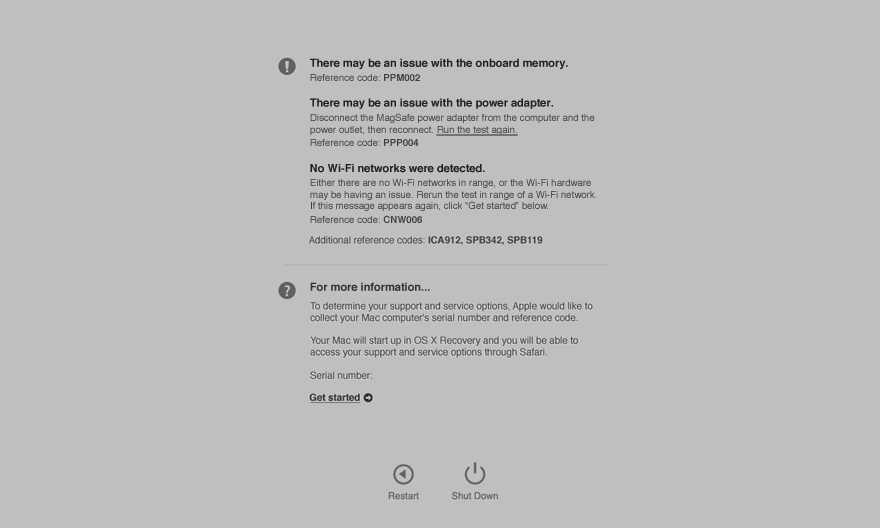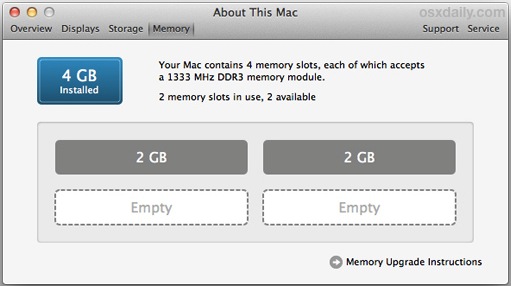Mac can be conveniently purchased from the Apple store and most of configuration allows you to upgrade the memory so that you don’t need to open the case and take the risk in using an incompatible memory which would cause system lockups.
The only thing is the upgrade from Apple store cost a lot more money if compared to the one that it purchased from a computer store. For example, an additional 2GB of memory cost $50 at Apple Store while it only cost less than $10 if you search in Pricewatch. If you’re willing to take the risk in adding extra memory in your Mac either to save money or perhaps you have a few lying around, it is best to run a memory test to make sure that the RAM is fully compatible and won’t make your Mac unstable.
If you don’t know how to check your disk space use on your Mac, here’s where to look. Options 1 and 2: From the Finder The Finder gives you a couple ways to see how much free disk space you have. A security message will appear, warning: “’CrucialMacScanner.app” can’t be opened because Apple cannot check it for malicious software.” Click “Open” to continue. The Crucial Mac Scanner will run and open with results in your default browser. Identify Your Computer DDR4 PC4-17000 DDR4-2133 PC4-19200 DDR4-2400 PC4-21300 DDR4-2666 PC4-23400 DDR4-2933 DDR3 PC3-8500 DDR3-1066 PC3-10600 DDR3-1333 PC3-12800 DDR3-1600 PC3-14900 DDR3-1866 DDR2 PC2-3200 DDR2-400 PC2-4200 DDR2-533 PC2-5300 DDR2-667 PC2-6400 DDR2-800 PC2-8500 DDR2-1066 DDR PC1600 DDR200 PC2100 DDR266 PC2700 DDR333 PC3200 DDR400.
Here we suggest 3 different methods to easily run a memory test on your Mac OS X including the latest Mountain Lion 10.8.
 1. Rember
1. RemberRember is actually a GUI for the popular command line memory testing tool called Memtest OS X. Instead of typing commands in terminal, you can run the test by clicking a button. You are able to test a selected amount or all of the memory, specify the number of times the tests should run and also viewing of the log. Rember includes Memtest OS X in the package so there is no need to manually download and install the memtest. Running Rember will show a table displaying the detected memory on your Mac. Select the amount of memory to test, number of loops and click the Test button to start checking the memory. When the tests is finished, Rember will show the test results.
Check Memory Mac Yosemite
Rember runs in Mac OS X which means that not all of the ram can be tested due to a portion of RAM being reserved for housekeeping.
Download Rember
2. Memtest86+
If your Mac has a SuperDrive, you can burn the pre-compiled bootable ISO image of the Memtest86+ and boot up the Mac with the disc. Just press and hold the C key when starting up Mac to boot from the disc.
The good thing about Memtest86+ is it runs by itself without relying on the operating system, giving you a more accurate memory test result.

Download Memtest86+
3. Apple Hardware Test
This is the recommended way by Apple to test your memory using their diagnostic tool. If you have an installation disc, insert the disc, restart your Mac, press and hold the C key. Select the language for the Apple Hardware Test and click the Test button to start testing. You can also tick the “Perform extended testing” option which would perform a more thorough test that takes considerably more time to complete. On the latest Mac OS X Mountain Lion, the Apple Hardware Test is already pre-installed and it doesn’t come with an installation disc. Simply boot up, press and hold the D key to start the Apple Hardware Test.
You can also see the amount of memory installed on your Mac at the Hardware Profile tab to confirm that the memory is correctly installed and detected. There are some Apple Hardware Test images that can be downloaded for older models. Do note that the Apple Hardware Test images are machine specific meaning that you cannot use the iBook version on a Mac Mini.
Download Apple Hardware Test
You might also like:
3 Ways to Test your RAM with Microsoft Windows Memory Diagnostic6 Free Programs to Check Your Video Card Memory For Errors10 Popular Web Browsers Tested for Memory and CPU UsageDownload Sony Memory Card File Rescue Software for Free.NET Framework Setup Verification Utility‘Closing all apps’ is an option which can be set or disabled in the Rember preferences.
ReplyI’m trying to test DRAM one bank at a time in mid-2010 Mac mini with 2 banks of 4GB Kingston DRAM each.
Rember run overnight on max cycles (255) showed when both banks were full (8GB total), there was a DRAM failure. But run overnight on max cycles (255), Rember is so slow it’s completed less than 30 cycles. I tried this twice.
Is it not possible to check one 4GB stick at a time? (Mid-2010 Mac mini standard RAM is 1GB module in each bank for total 2GB.)
ReplyI have several DDR3 DIMMs I want to install, but the memory timing is not printed on them. Is there an app for Macs that can tell you what the timing is on installed DIMMs?
ReplyRember doesn’t shut down existing programs… you do that yerself
Check Ram Usage On Mac

 Reply
ReplyRember is an amazing app! In regards to the comment above:
it closes all windows because to free-up whole RAM memory for tests.
It’s understandable that you must save your work before you open any diagnostic app.
Works great on latest 2019 iMac where Memtest failed and Apple Diagnostic Tool is a JOKE
ReplyRember
I ran this app and it closed all open windows and running apps without asking or warning me. That is bad software. Who knows what data I lost as a result, let alone time in reopening what I can remember was running. memtest does not do this.
Reply
Hope this works well, thanks!
ReplyLeave a Reply
Activity Monitor User Guide
You can see the amount of system memory being used on your Mac.
In the Activity Monitor app on your Mac, click Memory (or use the Touch Bar) to see the following in the bottom of the window:
Memory Pressure: Graphically represents how efficiently your memory is serving your processing needs.
Memory pressure is determined by the amount of free memory, swap rate, wired memory, and file cached memory.
Physical Memory: The amount of RAM installed.
Memory Used: The amount of RAM being used. To the right, you can see where the memory is allocated.
App Memory: The amount of memory being used by apps.
Wired Memory: Memory required by the system to operate. This memory can’t be cached and must stay in RAM, so it’s not available to other apps.
Compressed: The amount of memory that has been compressed to make more RAM available.
When your computer approaches its maximum memory capacity, inactive apps in memory are compressed, making more memory available to active apps. Look in the Compressed Mem column for each app to see the amount of memory being compressed for that app.
Cached Files: The size of files cached by the system into unused memory to improve performance.
Until this memory is overwritten, it remains cached, so it can help improve performance when you reopen the app.
Swap Used: The amount of space being used on your startup disk to swap unused files to and from RAM.
To display more columns, choose View > Columns, then choose the columns you want to show.
You can use Activity Monitor to determine if your Mac could use more RAM.
